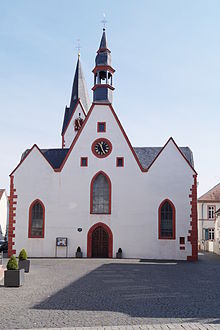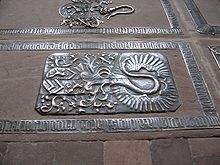St. Nicholas (Babenhausen)
The Protestant town church St. Nikolaus in the Hessian town of Babenhausen is a medieval church . It is a cultural monument due to the Hessian Monument Protection Act .
Building history
The oldest surviving mention of the church is said to be a document from Pope Urban IV from 1262. However, it is not known where it is located. The message is based on a tradition in literature that goes back to the 18th century. The document is not listed in the delivery of the documents of this Pope, the text that has been handed down does not name the patronage - in contrast to the usual form of the Papal documents of this time .
The church is said to have been founded in the first half of the 13th century. From this time, however, nothing is structurally recognizable today. The oldest preserved part are the lower parts of the Romanesque tower. The associated church was torn down in the 14th century and replaced by a new one in two construction phases. The first of these construction phases comprised the Gothic choir , which is still preserved today , started in 1383, with a 5/8 end . Its current vault, however, dates from 1939, as the original one was broken off in the 16th century. A side chapel was added to the choir around 1400.
After Babenhausen became the residence of the younger line of the Counts of Hanau through the division of the County of Hanau in 1458 , who later referred to themselves as Counts of Hanau-Lichtenberg , the church of their royal seat had to be upgraded accordingly. The Gothic nave, which is still preserved today, was erected as the second construction phase in 1472. It is a flat-roofed step hall with four bays .
After the Reformation, major alterations were made to the interior of the church from 1557, and in 1561 galleries were added on three sides of the nave . In 1594, the later Count Johann Reinhard I von Hanau-Lichtenberg , who resided in Babenhausen as an hereditary count , had the nave decorated and painted and the church received a pulpit .
In 1608 the church tower was destroyed by a hurricane. The reconstruction dragged on until 1614. Two hundred years later, in 1811, the spire was destroyed by fire and had to be renewed again. In 1861 the floor of the church was raised by 48 cm because the surface of the adjacent market square had meanwhile increased due to registered material.
In 1939 and 1940 the interior was extensively renovated. So the galleries were dismantled, only the lower level of the count's stalls on the north side remained. A short time later, however, the church was badly damaged by bombs in World War II .
Furnishing
Murals
The wall paintings come from different eras. The oldest are located on the north wall of the choir, are part of its original furnishings and can therefore be set before 1400. The death of Mary and the Last Judgment are shown .
The nave was also equipped with an extensive picture program around 1480, of which remains are still present and will also be shown after the last renovation. They are partially covered by more recent paintings, such as the medallion paintings by Eberhard Fischer around 1620 and the mannerist ornament painting with which the columns and arches of the nave were decorated around 1590.
The wall paintings were whitewashed in 1722 on the instructions of the church administration. They were only released from it during the renovation in 1939/1940.
altar
The carved winged altar from the second decade of the 16th century is the most valuable piece of furniture in the church.
Other items of equipment
- The font dates from the 15th century, was removed from the church in the course of the Reformation in 1545, survived the time in the parish garden at that time and was brought back to the church in the 19th century.
- The stately stalls that stand at the east end of the north aisle are the last remnants of the gallery architecture that was built into the church after the Reformation. Originally it was two-storey, the upper storey and the galleries were removed in 1939.
- The stained glass windows in the choir were added in 1954/1957.
- The choir is separated from the nave by a wrought iron rood screen .
The church as a burial place

The church served as the burial place of the Counts of Hanau-Lichtenberg since 1475. 16 members of the Hanau-Lichtenberg family are said to be buried in the crypt under the choir. In the choir there are also epitaphs and tombstones of some of these people. The epitaphs for Philip I, the elder , von Hanau-Lichtenberg, his wife Anna von Lichtenberg and two of their children, Johann and Dieter, who died young, are embedded in the south wall of the choir . They were created by Hans Merckel . The grave slabs of:
- Philip III from Hanau-Lichtenberg (western row)
- Margravine Sibylle von Baden-Sponheim , his wife (western row)
- Philipp I of Hanau-Babenhausen (eastern row)
- Anna von Lichtenberg , his wife (eastern row)
- Philip II of Hanau-Lichtenberg (eastern row)
- Anna von Isenburg , his wife (eastern row)
- Johann von Hanau (north of the high altar)
In addition, there are a number of tombs of other celebrities in the church. The Renaissance tomb of the knight Burkhard von Hertingshausen , who died in 1570, on the east wall of the south aisle of the nave is particularly noteworthy .
renovation
With the most recent renovation, which - with preliminary work - lasted from 2001 to 2006, the original floor height was restored. The entry of material in the 19th century had caused moisture to be sucked into the masonry. The height of the market square was adjusted, lowered towards the church and paved again. The foundations were drained and damaged masonry renovated. The church received a new sandstone floor, the pews were replaced and a new heating system installed. The murals have been restored. The roof and tower were also renovated and a new belfry was installed.
For the exemplary renovation of the city church, the Protestant parish of Babenhausen was awarded the Hessian Monument Protection Prize by the State Office for Monument Preservation in Hesse .
literature
- Lars Adler: The parish, residential and town church of Babenhausen in the mirror of aristocratic manors . In: Evangelical town church Babenhausen. The redevelopment 2001-2006 = workbooks of the State Office for Monument Preservation Hessen 24. Wiesbaden 2014, p. 13–34 ISBN 978-3-8062-2957-8
- Friedrich Karl Azzola : A relief in the western front of the town church of Babenhausen as a building document from 1472? In: Babenhausen Mosaik = Babenhausen then and now 20. Babenhausen 1990. pp. 24–29.
- Magnus Backes, Georg Dehio: Handbuch der Deutschen Kunstdenkmäler - Hessen , Munich 1982, p. 36, ISBN 978-3-422-00380-4 .
- Peter Blänkle: Human skeletal remains from the Protestant town church Babenhausen . In: Contributions to the history of the County of Hanau-Lichtenberg . Published for the 20th anniversary of the partnership between the two former royal royal cities of Babenhausen and Bouxwiller = Babenhausen once and now 49 (2004), p. 117ff.
- Siegfried RCT Enders: Monument topography Federal Republic of Germany - cultural monuments in Hesse - Darmstadt-Dieburg district . Braunschweig 1988.
- Evangelical Church Council Babenhausen (Ed.): Evangelical City Church Babenhausen . Babenhausen 1996.
- Claus Giel: The renovation measures on the nave, choir, tower and roof turret . In: Evangelical town church Babenhausen. The redevelopment 2001-2006 = workbooks of the State Office for Monument Preservation Hesse 24. Wiesbaden 2014, pp. 173–185. ISBN 978-3-8062-2957-8
- Hans Joachim Greifenstein: Evangelical town church Babenhausen. Tour of the church . Babenhausen. no year
- Christine Hartung: The late Gothic retable . In: Evangelical town church Babenhausen. The redevelopment 2001-2006 = workbooks of the State Office for Monument Preservation Hesse 24. Wiesbaden 2014, pp. 137–157. ISBN 978-3-8062-2957-8
- Max Herchenröder : Guide through the town church Babenhausen . Babenhausen 1940 u. 1966.
- Walter Hotz: The burial place of the first counts of Hanau-Lichtenberg in the choir of the town church in Babenhausen . In: Société d'Histoire et d'Archaeologie de Saverne et Environs (Eds.): Cinquième centenaire de la création du Comté de Hanau-Lichtenberg 1480 - 1980 = Pays d'Alsace 111/112 (2, 3/1980), p 55-58.
- Karin Lötzsch: A margrave of Baden between saints - the blessed Bernhard on the altar shrine in Babenhausen . In: Babenhäuser Mosaik = Babenhausen then and now 20. Babenhausen 1990. pp. 35–47.
- Wilhelm Morhardt: The double grave slab of the Knights of Babenhausen in the town church of Babenhausen 1246/1506 . In: Babenhäuser Mosaik = Babenhausen then and now 20. Babenhausen 1990. pp. 20–23.
- Wilhelm Morhardt: The tomb of Anna Magdalena Luise von Bernstorff (1688-1690) in Babenhausen . In: Babenhäuser Mosaik = Babenhausen then and now 20. Babenhausen 1990. pp. 30–34.
- Wilhelm Morhardt: Hanau old's - in honor of b'halt's - The Counts of Hanau-Lichtenberg in history and stories = Babenhausen then and now 10, Babenhausen 1984.
- Hans-Hermann Reck: The genesis of church construction from the beginnings in the 12th century to the end of the 20th century . In: Evangelical town church Babenhausen. The redevelopment 2001-2006 = workbooks of the State Office for Monument Preservation Hessen 24. Wiesbaden 2014, pp. 35–81 ISBN 978-3-8062-2957-8
- Michael Oberweis: The grave inscriptions of the town church Babenhausen . In: Evangelical town church Babenhausen. The redevelopment 2001-2006 = workbooks of the State Office for Monument Preservation Hessen 24. Wiesbaden 2014, pp. 159–172. ISBN 978-3-8062-2957-8
- Sebastian Scholz: The "Eternal Adoration" of Philip I of Hanau-Lichtenberg and his family. Forms of expression of aristocratic memoria and piety in the late Middle Ages . In: Contributions to the history of the County of Hanau-Lichtenberg. Published for the 20th anniversary of the partnership between the two former royal residence cities of Babenhausen and Bouxwiller = Babenhausen once and now 31 (2004), p. 19ff.
- Sebastian Scholz: The inscriptions of the city of Darmstadt and the district of Darmstadt-Dieburg and Groß-Gerau = The German inscriptions, Vol. 49, Mainz series, Vol. 6, ed. v. of the Academy of Sciences Mainz, Wiesbaden 1999.
- Stefan Schopf: The historical versions of the church interior - findings and concepts . In: Evangelical town church Babenhausen. The redevelopment 2001-2006 = workbooks of the State Office for Monument Preservation Hesse 24. Wiesbaden 2014, pp. 83–116. ISBN 978-3-8062-2957-8
Web links
Individual evidence
- ↑ See Adler, pp. 14-16.
- ^ Margit Krenn catalog of the wall paintings . In: Evangelical town church Babenhausen. The redevelopment 2001-2006 = workbooks of the State Office for Monument Preservation Hessen 24. Wiesbaden 2014, p. 126-136. ISBN 978-3-8062-2957-8
- ↑ Basically: Hartung.
- ^ Gerhard Bott: Count Friedrich Casimir von Hanau (1623-1685). The "King of the land of milk and honey" and his art treasures . Hanau 2015. ISBN 978-386314-215-5 , p. 11.
- ↑ Klaus Lötzsch: The newly discovered grave slab of Henrich von Wasen in the town church of Babenhausen . In: Klaus Lötzsch and Georg Witteberger: Contributions to the history of the county of Hanau-Lichtenberg = Babenhausen once and now 31 (2004), pp. 113–116.
- ↑ Basically: Giel.
Coordinates: 49 ° 57 ′ 45 ″ N , 8 ° 57 ′ 13 ″ E













